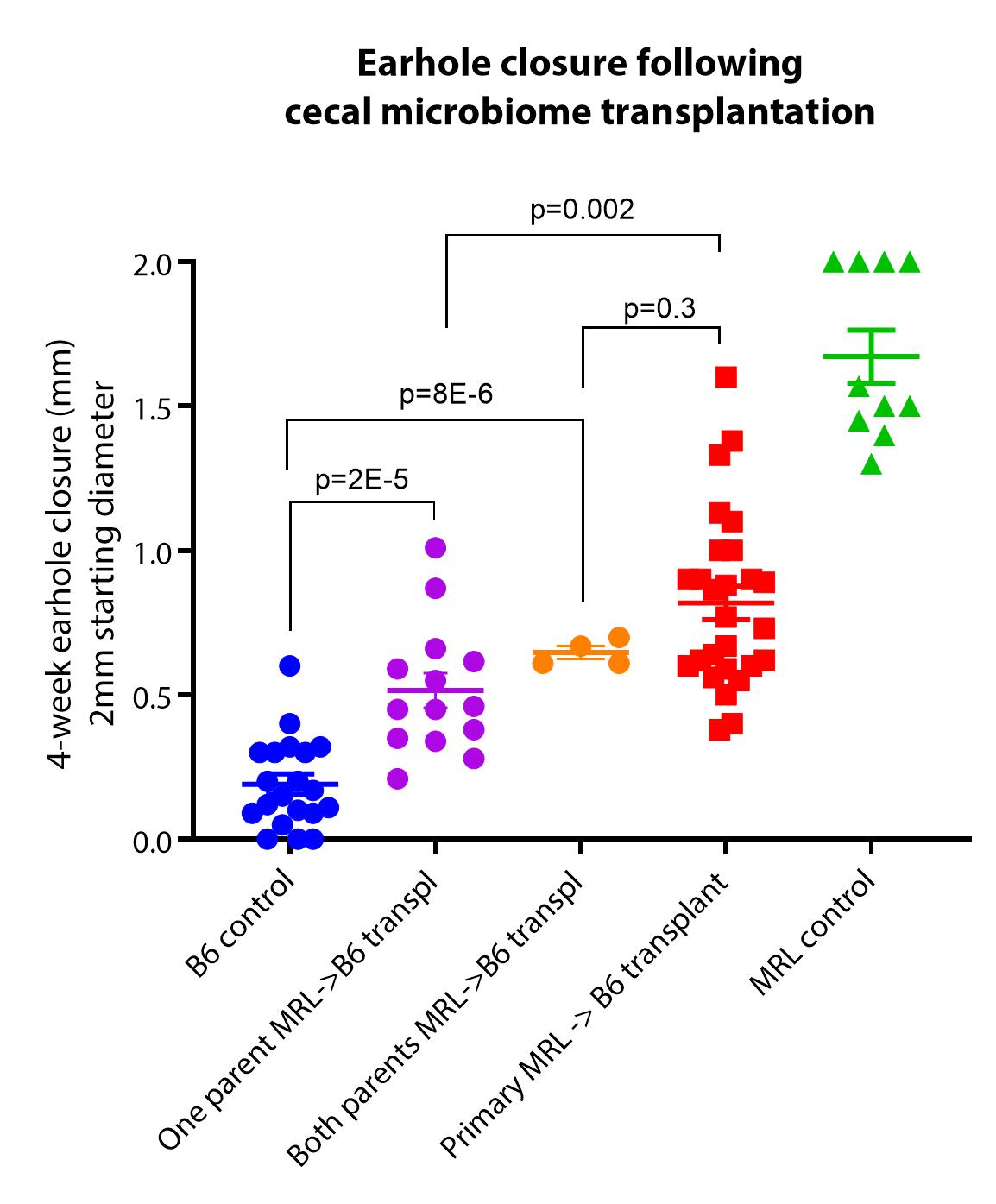Session Information
Session Type: Poster Session B
Session Time: 9:00AM-11:00AM
Background/Purpose: MRL/MpJ mice are substantially protected from developing post-traumatic osteoarthritis (OA), a trait with strong correlation to the ability to heal ear wounds. We have previously shown that this ear wound healing trait is partially determined by the gut microbiome, and that gut microbial transplantation into non-healer mice can confer the healing phenotype. In this study, we sought to examine whether the earhole healing phenotype associated with microbiome transplantation can be transgenerationally inherited.
Methods: Three-week-old C57BL6/J mice were inoculated by oral gavage with diluted cecal contents from adult male MRL/MpJ mice, or with vehicle control. Mice were then segregated into breeding cages, including cages where both parents were transplanted and cages where only one parent was transplanted. Offspring of these breeding pairs (n=4 for ‘both parents transplanted’, n=14 for ‘one parent transplanted’) received a 2mm earhole punch at 6 weeks of age, and final hole size was measured 4 weeks later. Group differences were compared to previous data on earhole closure from B6 vehicle, MRL vehicle, and primary B6- >MRL transplant mice.
Results: First-generation offspring wherein both parents received microbiome transplantation healed well (mean earhole closure at 4 weeks, mm, 0.65±0.02, p=8E-6 vs. B6 vehicle control) and were statistically indistinguishable from primary transplant mice (p=0.3). First-generation offspring wherein one parent was transplanted and the other also healing compared to vehicle B6 mice (earhole closure 0.52±0.08, p=2E-5 vs. B6 vehicle control), but worse than primary transplanted mice (p=0.002), Figure 1. 16S profiling of cecal microbiomes in each of these groups is ongoing.
Conclusion: The ear wound healing phenotype seen following cecal microbiome transplantation from healer MRL mice into nonhealer B6 mice is present in first generation offspring of transplanted mice. Further work will focus on identifying the key microbial clades being inherited which correlate with this phenotype, and examining any differences in healing based on mouse sex. Future studies should examine whether first generation offspring of transplanted mice are also protected against post-traumatic osteoarthritis.
 Earhole closure in animals following microbiome transplant, and their progeny.
Earhole closure in animals following microbiome transplant, and their progeny.
To cite this abstract in AMA style:
Dunn C, Garman C, Velasco C, Izda V, Martin J, Jeffries M. The Murine Ear Wound Cartilage Superhealer Trait, Mediated by the Gut Microbiome, Is Transgenerationally Heritable Following Cecal Transplantation [abstract]. Arthritis Rheumatol. 2020; 72 (suppl 10). https://acrabstracts.org/abstract/the-murine-ear-wound-cartilage-superhealer-trait-mediated-by-the-gut-microbiome-is-transgenerationally-heritable-following-cecal-transplantation/. Accessed .« Back to ACR Convergence 2020
ACR Meeting Abstracts - https://acrabstracts.org/abstract/the-murine-ear-wound-cartilage-superhealer-trait-mediated-by-the-gut-microbiome-is-transgenerationally-heritable-following-cecal-transplantation/
